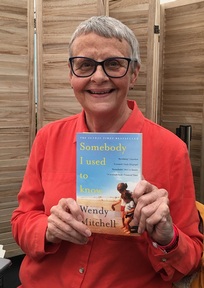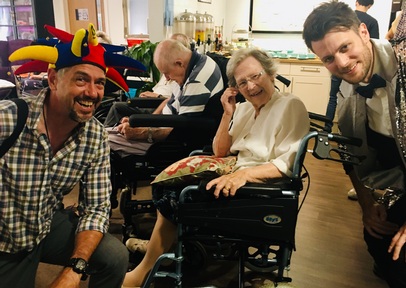For people with dementia, a doll acts as an 'anchor in ever-changing sea of uncertainty'
Dementia doll therapy is becoming increasingly popular in care homes in the UK, yet it is important to note that not everyone living with dementia will engage with or even benefit from doll therapy, according to dementia doll therapy expert Gary Mitchell.

Care homes find that with some residents with dementia, giving them a doll to cuddle and talk to can be hugely comforting and can be very useful in calming them if they are distressed and agitated.
However Mr Mitchell, who has written a book Doll Therapy in Dementia Care, points out that studies have shown that it is difficult for even the most experienced practitioners to predict how a person living with dementia will respond to doll therapy. He has found that people living with an advanced form of dementia appear to be the biggest users of doll therapy.
Mr Mitchell qualified as a nurse in 2010 and is a resident experience care specialist at Four Seasons Health Care. He believes that if dementia doll therapy is used correctly, it can make a real positive difference to a person with dementia.
Dolls act as an anchor
He attributes this to a “need for attachment in a time of greater uncertainty” and says: “For people living with dementia a doll can arguably act as an anchor in an ever-changing sea of uncertainty”.
Doll therapy is still viewed by some with suspicion as it can be perceived as “infantile, childish, demeaning and patronising”, according to Mr Mitchell who admits “these were the feelings that I had when I first observed doll therapy in my nursing practice at Four Seasons Health Care. However, through exposure and education I have not only accepted doll therapy – I have embraced it”.
Care home staff do need to monitor residents’ interactions with the dolls very carefully. Some care homes have found residents can get too attached to the dolls, putting them to sleep in their beds, for example, while they sleep in the chair. They have also led to arguments between residents.
Four Seasons Healthcare has found residents have become so attached to the dolls there have been tussles over them. It has even had to go as far as introducing baby high chairs into the dining halls so residents could feed their dolls while eating their meals.
However there are huge benefits with studies showing that doll therapy does lead to increased levels of engagement with other people, reduction in episodes of distress, improved dietary intake and generally an increased level of wellbeing with the therapy now used in the UK, Australia, Japan and the USA.
For care homes interested in going down the dementia doll therapy route, Mr Mitchell advises:
1. Communication: Inform family and healthcare professionals before the introduction of dolls. Family members should be provided with a summary of the potential benefits. Importantly, all parties must be made aware that when a doll is introduced and is accepted by a person with dementia, it will not usually be removed.
2. If doll therapy is to be utilised by more than one person with dementia in the same unit, healthcare professionals should seek to provide different styles of doll (i.e. wearing different clothes). This will limit potential confusion over doll ownership as a doll should only belong to one person.
3. Avoid dolls that cry, or have their eyes closed. These have been shown to distress some people with dementia who engage with dolls either because they can’t stop their doll from crying or they believe their doll to be a baby that has died.
4. Assist people with dementia to make their own choice about engaging with dolls (i.e. do not force them on everyone, rather place them in an area where people with dementia can make their own decisions). Naturally, this can be difficult as mobility or sight of the person is reduced.
5. Keep accurate care plans relating to the doll therapy. Of particular importance is monitoring levels of fatigue as caring for a doll as if it were a baby is a tiring process.
6. If a person with dementia calls their doll by a certain name, all healthcare professionals and family members should be encouraged to do the same. Also if the resident believes the doll to be a baby this should also not be invalidated.
7. The doll should never be removed without the permission of the person of dementia. When removing the doll, healthcare professionals and family members should hold the doll as if it was a living baby and explain where they are taking the doll (i.e. if it is dirty, the doll is going for a wash).
8. If storing the baby, do not place it in a box, on the floor, on a radiator etc. It should be placed in a safe place as the person engaging with dolls may perceive their baby to be in danger.
You can find further information on dementia doll therapy in Gary Mitchell’s book, Doll Therapy in Dementia Care
Or you can contact him @GaryMitchellRN or via his email Gary.Mitchell@fshc.co.uk
Latest Features News
 25-Nov-19
2019 Election: Boris Johnson leaves social care in 'too difficult box' but Labour vows to end 'crisis'
25-Nov-19
2019 Election: Boris Johnson leaves social care in 'too difficult box' but Labour vows to end 'crisis'
 18-Oct-19
Podcast: Wendy Mitchell and dementia: 'My biggest fear is not knowing who my daughters are'
18-Oct-19
Podcast: Wendy Mitchell and dementia: 'My biggest fear is not knowing who my daughters are'
 27-Sep-19
Exclusive: Care minister backs care workers' call for time off to grieve and attend funerals
27-Sep-19
Exclusive: Care minister backs care workers' call for time off to grieve and attend funerals
 19-Sep-19
Podcast: Gyles Brandreth says poetry helps ward off dementia
19-Sep-19
Podcast: Gyles Brandreth says poetry helps ward off dementia
 30-Aug-19
Edinburgh Fringe funnyman joins comics facing toughest audience at care home gig
30-Aug-19
Edinburgh Fringe funnyman joins comics facing toughest audience at care home gig